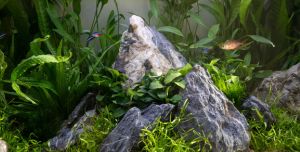Whether you are new to fish keeping or an experienced aquarist, correct care for your aquarium plants is a must. Here is everything you need to know about aquarium plant care.
Are live plants good for a fish tank?
Live plants are essential for creating a healthy and balanced environment in aquariums. Through photosynthesis, they produce oxygen, which is necessary for fish to survive. Making it much more appealing than artificial plants that don’t have any biological functions.
Benefits of Live Plants in a Fish Tank
No matter what type of fish tank you have, adding live plants is a great way to help create an aesthetically pleasing and functional environment for your fish. Here are some benefits that live plants can provide:
- Improves water quality
- Provides oxygen for your fish
- Reduces stress for your fish
- Creates a natural habitat for fish
- Helps control algae growth
- Enhance the aesthetics of a fish tank
Types of aquarium plants
When it comes to aquarium plants, there are two main types – live and plastic.
Live plants
Live plants are the most popular choice for aquariums. They require more maintenance, but offer many benefits that plastic plants do not. Some of the most popular freshwater aquarium plants include:
- Amazon Sword
- Anubias
- Java Fern
- Vallis
- Java Moss
All these plants should be planted in a substrate and need to be trimmed regularly for optimal plant growth. For instance, soil substrates specifically designed for aquarium plants are a great way to help your plants thrive.
These soil substrates offer the right combination of nutrients, aeration, and drainage that aquatic plants need to stay healthy. They also help anchor the plant in place while providing oxygen to its roots.
Plastic plants
If you are looking for a low-maintenance option, then plastic plants are the way to go. They don’t require any maintenance and can last for years without needing to be replaced. However, they do not offer the same benefits as live plants, such as providing oxygen for your fish.
Should you choose to add plastic plants to your tank, be sure they are made from non-toxic materials, designed specifically for aquariums.
Planting your aquarium plants
Planting your aquarium plants is a simple process that can make a big difference in the health and wellbeing of your fish. Here are some tips to help you successfully plant your aquatic plants:
- Choose the right plants for your aquarium. Specific plants have requirements for light, temperature, and water chemistry. Research which plants will do well in your aquarium’s conditions.
- Prepare your aquarium substrate. Many aquarium plants require a nutrient-rich substrate to grow well. You can use specialised aquarium soil or add nutrients to your gravel or sand substrate.
- Rinse your plants before planting. This will remove any dirt or debris that may be on the plants.
- Plant your aquarium plants. Use your fingers or a planting tool to gently press the plants into the substrate. Make sure the roots are covered, but don’t bury the stems too deeply.
- Add fertiliser. Many aquarium plants benefit from regular doses of liquid fertiliser.
- Provide proper lighting. Most aquarium plants require moderate to high levels of light to grow well. Make sure your aquarium lighting is appropriate for the plants you have chosen.
- Monitor your plants. Check your plants to make sure they are growing well. Trim any dead or dying leaves and adjust your fertilisation and lighting as needed.
How to clean your plastic aquarium plants
Regularly cleaning your aquarium plants can help keep them algae & debris free. To clean your plastic aquarium plants, if possible remove from the aquarium and then remove any excess dirt or algae from the leaves and stems. Use a soft brush to gently scrub the surface of the plant.
Once cleaned, rinse the plant with dechlorinated water, before returning it to the aquarium. You can also use specialised aquarium plant cleaners like Plastic Plant and Ornament Cleaner to remove stubborn algae buildup. Be sure to read the directions and safety warnings on any chemicals you use before applying them to your plants.
Do aquarium plants need water changes?
As you may already assume, aquarium water changes are essential for healthy plants. In addition to removing toxins and replenishing needed nutrients. Water changes should be done once a month (every 28 days), at the same time as cleaning your aquarium filter. Try to do at least 20% of the aquarium each time for best results.
Do aquarium plants cause algae?
Algae thrives off of nutrients such as phosphates and nitrates. This can build up when fish waste, uneaten food, and decaying plant matter aren’t removed from the tank regularly. If you have too many fish or do not perform regular water changes, then this extra nutrient supply can lead to an algae bloom.
To prevent algae growth, keep your aquarium clean by performing routine water changes and removing any food or decay from the tank. Also, consider adding some fast-growing plants to help absorb excess nutrients before they contribute to algae growth.
How much light do my aquarium plants need?
In order for aquarium plants to thrive, they need a good balance of light and nutrients. The amount of light your aquarium plants need will depend on the type of plant you are growing. Low-light plants such as Anubias and Java Fern can do well with a lot less light than higher demanding light plants such as stem plants or grasses.
What type of light is best for aquarium plants?
LED lights are generally the best option for aquariums. LED lights come in an array of colours and wattages, and can be tailored to any aquarium environment. Many LED lights also come with a controller, which allows you to adjust the intensity and colour spectrum for optimal plant growth. LED lights are more energy efficient than other types of aquarium lighting, so they are better suited.
How can I make my plants grow faster?
Different aquarium plants require different care instructions. Research the specific requirements for each plant and follow the instructions closely.
- Adjust light. Proper lighting is essential for growing healthy aquarium plants. Test your lighting levels regularly and make sure they are appropriate for your plants’ needs.
- Use fertilisers. Adding liquid fertiliser to your tank can help provide essential nutrients to your plants. Make sure you read the directions and use the fertiliser as directed.
- Trim plants. Trimming off dead or dying leaves can help encourage fresh growth in your plants.
- Change water regularly. Regular water changes remove toxins and replenish essential nutrients for your plants. Aim for a water change every month (28 days). At the same time as cleaning your aquarium filter.
- Provide proper filtration. Having an adequate filtration system helps keep any debris and toxins from accumulating in your tank, which can stress out plants or reduce their growth rate.
- Monitor pH levels. Knowing the pH levels of your aquarium is essential for growing healthy plants. Aim for a slightly acidic pH, around 6.5 to 7.
Why are my aquarium plants dying?
There are several reasons your aquarium plants may be dying. One common reason is poor water quality. Another reason could be inadequate lighting, as plants require a certain amount of light to photosynthesise and grow.
Over or little fertilisation can also harm plants, as too much or too little nutrients can cause harm. It’s also important to consider the type of plants you have and whether they are suitable for the conditions in your aquarium, such as temperature and pH levels.
Overcrowding or improper pruning can also lead to death. By addressing these potential issues, you can help prevent further plant loss and promote a healthy and thriving aquarium ecosystem.





